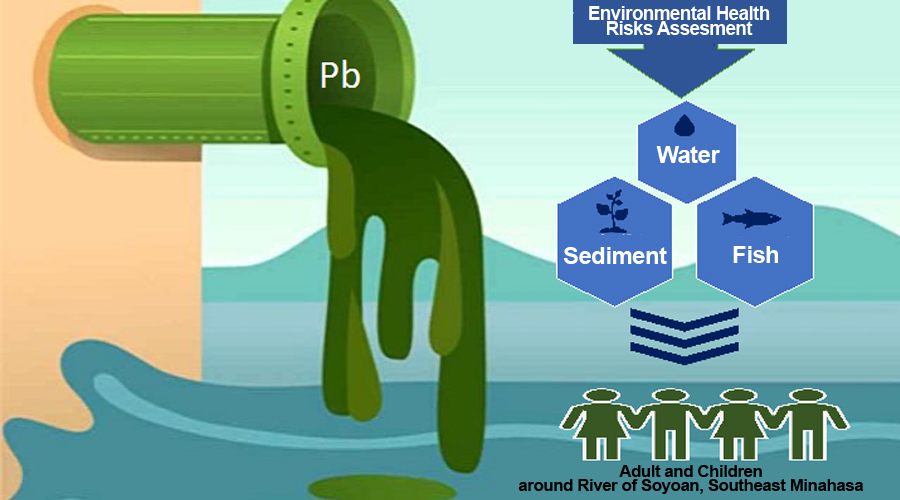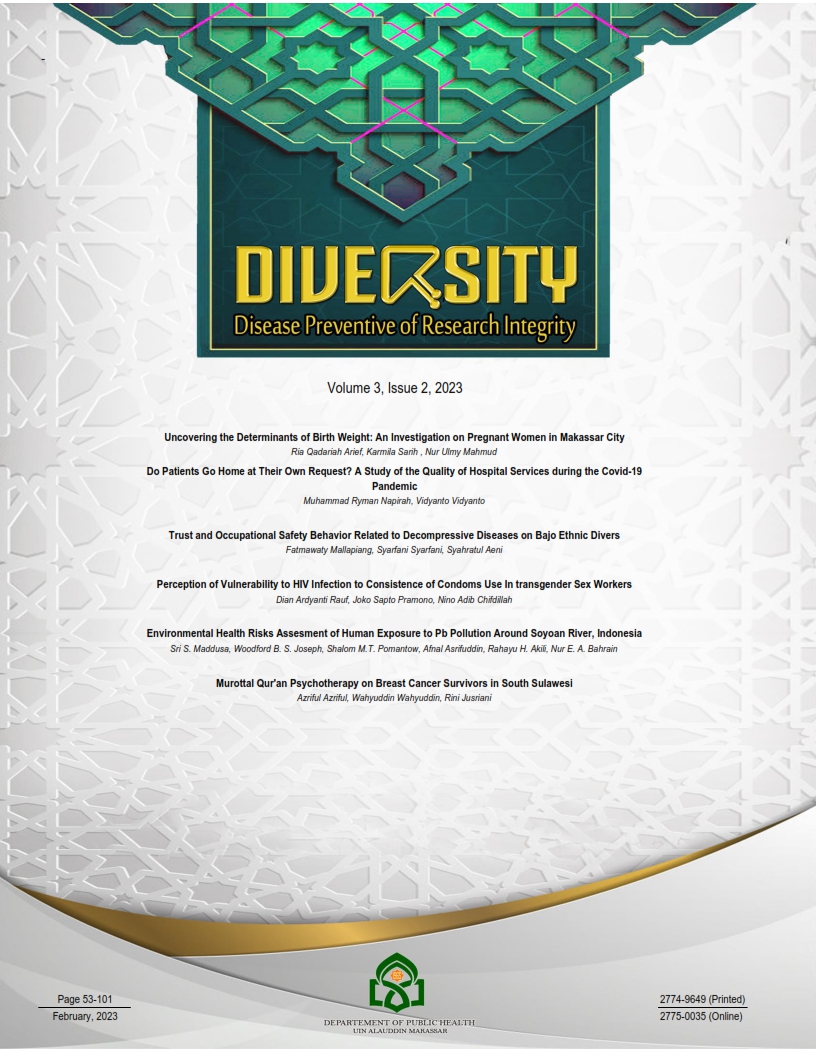Environmental Health Risks Assesment of Human Exposure to Pb Pollution Around Soyoan River, Indonesia
Abstract
The presence of the heavy metal lead (Pb), which accumulates in water and sediment, will enter into the life of organisms which can have a toxic effect on the organisms in it. This study aimed to analyze the health risks of consuming Mujair fish (Oreochromis Mossambicus) which contains the heavy metal Pb in the river flow of Soyoan Village, Ratatotok District, Southeast Minahasa Regency. The research method was descriptive with an environmental health risk analysis (ARKL) approach. Determination of lead levels in fish, water, and sediments used the Atomic Absorption Spectrophotometer method with a graphite furnace. The results showed that the average Pb in Mujair fish was 0.23 mg/kg, the average Pb in water was 1.48 mg/liter, and the average in sediment was 52.98 mg/kg. Pb concentrations in aquatic fish and sediments had exceeded the threshold. The Risk Quotion (RQ) value wasstill below 1 (RQ < 1), meaning that Mujair fish (Oreochromis Mossambicus) in the Soyoan river was still safe for consumption. The ECR value ≤ 10-4 indicated that making risk management was not something that needs to be prioritized. However, the presence of high concentrations was an indicator so that the rate of intake and frequency of exposure can be reduced. In Islamic teachings, it has been explained that damage to the environment due to human actions has an adverse effect on the biota and threatens the surrounding community's health.

Downloads
References
Ali, H., & Khan, E. (2019). Trophic transfer, bioaccumulation, and biomagnification of non-essential hazardous heavy metals and metalloids in food chains/webs—Concepts and implications for wildlife and human health. Human and Ecological Risk Assessment: An International Journal, 25(6), 1353-1376. https://doi.org/10.1080/10807039.2018.1469398
Alik, O., Joseph, W.B. and Maddusa, S.S. (2022). Analisis Risiko Kesehatan Lingkungan Paparan Logam Berat Merkuri (HG) pada Masyarakat Sekitar Sungai yang Mengonsumsi Ikan Nilem (Ostoechillus Vittatus) dari Sungai Desa Bakan Kecamatan Lolayan Kabupaten Bolaang Mongondow. KESMAS, 11(1). https://ejournal.unsrat.ac.id/index.php/kesmas/article/viehttps://www.pla.co.uk/Environment/Canadian-Sediment-Quality-Guidelines-for-the-Protection-of-Aquatic-Lifew/39212
Alim, D. H. (2014). Konsentrasi logam berat timbal (Pb) pada air, sedimen, dan rumput laut Sargassum polycystum di perairan pulau pari kepulauan seribu.[Skripsi]. Bogor.(ID): Institut Pertanian Bogor. https://repository.ipb.ac.id/handle/123456789/74431
Alwi, J., & Yasnani, Y. (2016). Analisis Risiko Kesehatan Lingkungan Akibat Pajanan Timbal (Pb) pada Masyarakat yang Mengonsumsi Kerang Kalandue (Polymesoda Erosa) dari Tambak Sekitar Sungai Wanggu dan Muara Teluk Kendari. JIMKEMAS. 1(3). http://ojs.uho.ac.id/index.php/JIMKESMAS/article/view/1223
Baharuddin, A., & Musa, M. N. (2018). Environmental ethics in Islam. In Islamic Bioethics: Current Issues & Challenges (pp. 161-182). https://doi.org/10.1142/9781783267507_0008
Birungi, Z., Masola, B., Zaranyika, M. F., Naigaga, I., & Marshall, B. (2007). Active biomonitoring of trace heavy metals using fish (Oreochromis niloticus) as bioindicator species. The case of Nakivubo wetland along Lake Victoria. Physics and Chemistry of the Earth, Parts A/B/C, 32(15-18), 1350-1358. https://doi.org/10.1016/j.pce.2007.07.034
Cañedo-Argüelles, M., Kefford, B. J., Piscart, C., Prat, N., Schäfer, R. B., & Schulz, C. J. (2013). Salinisation of rivers: an urgent ecological issue. Environmental pollution, 173, 157-167. https://doi.org/10.1016/j.envpol.2012.10.011
CCME. (2001). Canadian Sediment Quality Guidelines for the Protection of Aquatic Life. Canada. Canadian Environmental Quality Guidelines. https://www.pla.co.uk/Environment/Canadian-Sediment-Quality-Guidelines-for-the-Protection-of-Aquatic-Life
Darmono. (2001). Lingkungan hidup dan pencemaran: hubungannya dengan toksikologi senyawa logam. Universitas Indonesia. Jakarta
Dutta, J., Zaman, S., Thakur, T. K., Kaushik, S., Mitra, A., Singh, P., & Datta, R. (2022). Assessment of the bioaccumulation pattern of Pb, Cd, Cr and Hg in edible fishes of East kolkata Wetlands, India. Saudi Journal of Biological Sciences, 29(2), 758-766. https://doi.org/10.1016/j.sjbs.2021.09.039
Harahap, A. (2022). Analysis of Heavy Metals in Water and Sediment in Singkep Island Coastal Waters. International Journal of Science and Environment (IJSE), 2(3), 67-73. https://doi.org/10.51601/ijse.v2i3.49
Julhidah, J. (2018). Kadar Logam Kadmium (Cd) Dan Timbal (Pb) Pada Hati, Ginjal Dan Daging Ikan Kembung (Rastraliger Kanagurta) Di Pantai Losari Makassar (Doctoral dissertation, Universitas Islam Negeri Alauddin Makassar). http://repositori.uin-alauddin.ac.id/13187/
Kahlon, S. K., Sharma, G., Julka, J. M., Kumar, A., Sharma, S., & Stadler, F. J. (2018). Impact of heavy metals and nanoparticles on aquatic biota. Environmental chemistry letters, 16, 919-946. https://doi.org/10.1007/s10311-018-0737-4
Kamran, M., Cheema, A. M., Saima, M. I. T. K., Fatima, Z., Nosheen, B., & Shahid, M. K. (2022). Global Concern Of Air Pollution And The Case Of Pakistani Soci-ety: An Islamic Perspective On Green Environment. Webology (ISSN: 1735-188X), 19(1). https://www.webology.org/abstract.php?id=3419
Liono, V. V., Joseph, W. B., & Maddusa, S. S. (2022). Analisis Risiko Kesehatan Lingkungan Paparan Logam Berat Arsen (As) pada Masyarakat Sekitar Sungai yang Mengonsumsi Ikan Nilem (Ostoechillus Vittatus) dari Sungai Desa Bakan Kecamatan Lolayan Kabupaten Bolaang Mongondow. KESMAS, 11(2). https://ejournal.unsrat.ac.id/index.php/kesmas/article/view/39248
Maddusa, S.S., Girikallo, G. G., Alik, O., Liono, V. V., Joseph, W. B., & Sondakh, R. C. (2022). Risiko Kesehatan Lingkungan Paparan Logam Berat Pada Ikan Nilem (Ostoechillus vittatus) di Desa Bakan Kecamatan Lolayan Kabupaten Bolaang Mongondow. HIGIENE: Jurnal Kesehatan Lingkungan, 8(1), 1-6. https://journal3.uin-alauddin.ac.id/index.php/higiene/article/view/30946
Maurya, P. K., Malik, D. S., Yadav, K. K., Kumar, A., Kumar, S., & Kamyab, H. (2019). Bioaccumulation and potential sources of heavy metal contamination in fish species in River Ganga basin: Possible human health risks evaluation. Toxicology reports, 6, 472-481. https://doi.org/10.1016/j.toxrep.2019.05.012
Moiseenko, T. I., Morgunov, B. A., Gashkina, N. A., Megorskiy, V. V., & Pesiakova, A. A. (2018). Ecosystem and human health assessment in relation to aquatic environment pollution by heavy metals: case study of the Murmansk region, northwest of the Kola Peninsula, Russia. Environmental Research Letters, 13(6), 065005. http://www.doi.org/10.1088/1748-9326/aab5d2
Okereafor, U., Makhatha, M., Mekuto, L., Uche-Okereafor, N., Sebola, T., & Mavumengwana, V. (2020). Toxic metal implications on agricultural soils, plants, animals, aquatic life and human health. International journal of environmental research and public health, 17(7), 2204. https://doi.org/10.3390/ijerph17072204
Putra, P. D. S., Sulistyani, S., & Budiyono, B. (2016). Analisis Risiko Kandungan Timah Hitam (Pb) pada Ikan Belanak di Sungai Tapak Kota Semarang. Jurnal Kesehatan Masyarakat (Undip), 4(5), 85-93. https://doi.org/10.14710/jkm.v4i5.14485
Sembe,l D. (2015). Toksikologi Lingkungan. CV. Andi Offset: Yogyakarta
Simbolon, A. R. (2018). Analisis risiko kesehatan pencemaran Timbal (Pb) pada kerang hijau (Perna viridis) di Perairan Cilincing Pesisir DKI Jakarta. OLDI (Oseanologi dan Limnologi di Indonesia), 3(3), 197-208. http://dx.doi.org/10.14203/oldi.2018.v3i3.207
Song, Z., Zhang, C., Yang, G., Feng, Y., Ren, G., & Han, X. (2014). Comparison of biogas development from households and medium and large-scale biogas plants in rural China. Renewable and Sustainable Energy Reviews, 33, 204-213. https://doi.org/10.1016/j.rser.2014.01.084
Sukma, R. M., Gafur, A., & Abbas, H. H. (2020). Biokonsentrasi Logam Berat Timbal, Arsen pada Air dan Ikan Sungai Tallo Kota Makassar. Window of Public Health Journal, 404-416. https://doi.org/10.33096/woph.v1i4.110
United States Environmental Protection Agency. (2022). IRIS Advanced Search https://iris.epa.gov/AdvancedSearch/?keyword=rfd (Accessed August 2022).
Yuan, Z., Nag, R., & Cummins, E. (2022). Human health concerns regarding microplastics in the aquatic environment-From marine to food systems. Science of The Total Environment, 153730. https://doi.org/10.1016/j.scitotenv.2022.153730
Zaynab, M., Al-Yahyai, R., Ameen, A., Sharif, Y., Ali, L., Fatima, M., & Li, S. (2022). Health and environmental effects of heavy metals. Journal of King Saud University-Science, 34(1), 101653. https://doi.org/10.1016/j.jksus.2021.101653
Copyright (c) 2023 Sri Seprianto Maddusa, Woodford B. S. Joseph, Shalom Messy Thessalonika Pomantow, Afnal Asrifuddin, Rahayu H. Akili, Nur Evira Anggrainy Bahrain

This work is licensed under a Creative Commons Attribution-NonCommercial-ShareAlike 4.0 International License.
Authors retain copyright and grant the journal right of first publication with the work simultaneously licensed under a Creative Commons Attribution-NonCommercial-ShareAlike 4.0 International License that allows others to share the work with an acknowledgment of the work's authorship and initial publication in this journal.
Authors are able to enter into separate, additional contractual arrangements for the non-exclusive distribution of the journal's published version of the work (e.g., post it to an institutional repository or publish it in a book), with an acknowledgment of its initial publication in this journal.
Authors are permitted to publish their work online in third parties as it can lead to wider dissemination of the work.




